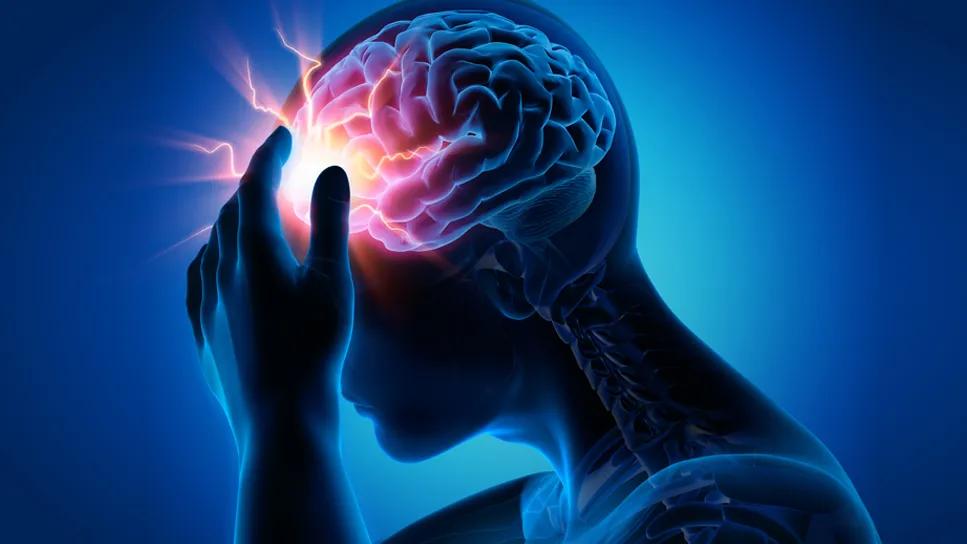A flow of dehumidified room air delivered via at-home device modulates sphenopalatine ganglion

Conditioned room air delivered transnasally is safe, effective and tolerable for treatment of acute migraine, according to findings from a new study led by a Cleveland Clinic researcher.
Advertisement
Cleveland Clinic is a non-profit academic medical center. Advertising on our site helps support our mission. We do not endorse non-Cleveland Clinic products or services. Policy
The results provide the first proof-of-concept for the Mi-Helper, a noninvasive device by My-Helper Inc., which requires no drugs or chemicals. They were presented at the American Academy of Neurology Annual Meeting in San Diego, California.
“The Mi-Helper induces local cooling in the nasal cavity, which calms or inhibits the sphenopalatine ganglion, a nerve bundle behind the nasal passage involved in migraine pathophysiology,” says lead author and Cleveland Clinic neurologist MaryAnn Mays, MD. “We found that delivery of 10 liters per minute of transnasal dehumidified room air through the device resulted in complete pain freedom in 47% of migraine patients at two hours, compared to only 16% in the sham group.”
Migraine is the second leading cause of disability and affects 37 million Americans, with a female predominance. A variety of medications are available for the condition, but for many patients, they produce inadequate relief or are associated with contraindications or intolerable side effects. Thus, there is a critical need for alternative approaches.
Neuromodulation is an expanding field in headache medicine that may address this care gap. Several neuromodulation devices have been approved by the U.S. Food and Drug Administration for migraine. Most involve either electrical or magnetic stimulation of the trigeminal or vagus nerves and some must be used in a clinical setting or require specialized training.
The Mi-Helper, by contrast, is a portable, patient-operated tabletop device. Ambient air is drawn into it, dried using molecular sieve desiccant media in a cartridge, and then delivered to the nose via a single-use tubeset.
Advertisement
“This is the first-ever noninvasive neuromodulator device that targets the sphenopalatine ganglion,” says Dr. Mays. “It’s a natural alternative that has potential to be used as a standalone or in conjunction with other abortive therapies for acute migraine.”

The objectives of the randomized, prospective, double-blind study were to evaluate the safety, tolerability and efficacy of the Mi-Helper for acute treatment of migraine with or without aura. The participants were adults 18 to 65 who reported having two to eight migraine attacks and less than 15 migraine days in the 28 days prior to enrollment.
Of the 172 participants randomized, 128 used the Mi-Helper and were included in the modified intention-to-treat analysis for efficacy. Forty-four used a sham device.
The participants self-administered the device in their homes to treat a single migraine attack. Mi-Helper doses tested were 4 liters per minute (LPM), 6 LPM and 10 LPM, with both the active and sham devices to be used for 15 minutes within one hour of migraine onset.
Primary efficacy endpoints were the proportion of patients achieving pain relief and pain freedom at two hours after treatment. Secondary endpoints included tolerability and sustained pain freedom between two and 24 hours after treatment. Safety was measured based on incidence of device-related adverse events (AEs).
A statistically significantly higher percentage of participants who used the Mi-Helper at 10 LPM were pain-free at two hours compared to the sham group (47.1% vs. 16.0%; P=0.029). The 10 LPM group also achieved greater pain relief at two hours after treatment than the sham group, although the difference was not statistically significant (70.6% vs 56.0%; P=0.339).
Advertisement
Pain freedom without rescue medication from two to 24 hours after treatment was numerically higher in the 10 LPM group compared to the sham group (41.2% vs. 16%; P=0.069). Those findings, says Dr. Mays, are “a trend toward significance meriting further investigation.”
None of the participants discontinued use of the Mi-Helper early because of discomfort and there were no serious AEs. All device-related AEs (ADEs) were mild or moderate, with the most common being rhinorrhea in four participants in the 10 LPM group. Only one participant, also in the 10 LPM group, required concomitant medication for an ADE.
Additional clinical trials of the Mi-Helper are planned, with the hope that the research will lead to commercial availability for treatment of acute migraine in 2026. Reducing the size of the device to make it even more portable and exploring use for cluster headaches, trigeminal neuralgia or mood disorders also may be on the horizon, according to Dr. Mays.
“Our data show that a very short treatment with transnasal dry air delivers immediate and durable relief from migraine pain without the need for additional therapy,” she says Dr. Mays. “It offers patients the potential for relief at home or at work and decreased reliance on opioids, with little or no side effects and a low cost.”
Advertisement
Advertisement

A close look at the growing array of options for episodic and chronic migraine

Case study of radial-to-axillary nerve transfer for tumor-related deltoid nerve injury

An update on the technology from the busiest Gamma Knife center in the Americas

Real-time adjustments may help reduce bothersome dyskinesias

Anatomical modeling can identify optimal surgical candidates, study suggests

Add AI to the list of tools expected to advance care for pain patients

New guidelines from Brain Trauma Foundation urge early and aggressive treatment

Cleveland Clinic study investigated standard regimen